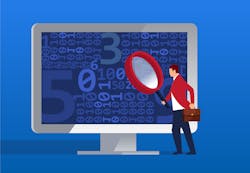Few if any know what the future holds right now. In the trucking maintenance world, there is refuge in the form of vehicle maintenance reporting standards (VMRS). These are the numerical coding designations that comprise the universal language shops use to communicate what is happening in a truck’s life and why. Starting around 1970, they have been developed and licensed by the American Trucking Associations for communication and benchmarking purposes, with new codes added all the time (such as for battery-electric powertrains).
For example, within a component code, there’s a trio of three-digit sequences, each of which clarifies a vital piece to the puzzle. The first is the system, the second is assembly, and third is the specific component on a vehicle. There are more than 33,000 variations. For a diesel particulate filter, the code is 043 006 017. That means within the exhaust system (043), for the aftertreatment assembly (006), and then the DPF itself (017).
Then you combine that with the code key 14 for reason for repair and code key 15 for work accomplished, and you have a whole synopsis in a dozen or so characters, as opposed to a paragraph or two.
“VMRS was really developed to keep typing at a minimum,” explained Jack Poster, VMRS services manager for the ATA’s Technology & Maintenance Council, on a recent webinar hosted by Infor and FleetOwner. “Techs are paid to work on vehicles. They're not typists. Some technicians are going to spend longer typing in a work order than they are doing the repair.”
The shorthand codes also eliminate any guesswork or confusion. Techs are left with just the facts.
In that way, it reminds Poster of one of his favorite television show characters, Police detective Sgt. Joe Friday of “Dragnet.”
“He just wanted the facts. He didn't want any stories. He didn't want any embellishments,” Poster said. “In today's world, it's important that we stick with the facts.”
And for Poster, that’s what VMRS does.
“It does away with anecdotal information,” he explained. "Any facility I've ever worked at, any garage, manufacturer, there was always somebody who said ‘I don't like Brand X for this reason.’ And when you quiz them further, they really can't give you a good answer.”
Everything within this coding system is about precision. There are 64 main code keys that help to organize everything from the type of equipment vocation (12 for linehaul) to category (5 for tractor-trailer) to reason for repair (01 for a breakdown). There are also codes for each manufacturer. Together, these codes offer the quantitative data a fleet can investigate to discover the truth in an easily searchable way.
“If you want to do a report on what [you’re] spending on diesel particulate filters in a given day, month, week, year, you type in the nine-digit number in your system, you can pull that up. It'll give you that information,” Poster said.
This allows a fleet to compare parts and find which ones “are chewing you up” from a cost standpoint Poster said. “VMRS quickly identifies and helps drive down maintenance costs by using these codes.”
One of the key benefits of the reason for repair is recording the historical environment in which a maintenance event occurred. Before making a new equipment purchase, a fleet can look back and see how a certain OEM’s trucks performed for them. If they just went by time in shop, that leaves a lot open to interpretation.
But if they drill down, they may see the code for outside influence. Poster said some recent tornadoes could cause that code. And when a truck is towed, that doesn’t necessarily mean the truck failed. This code could indicate the driver exceeded hours of service, a load shift or an accident.
Poster noted that VMRS also provides the power not only to look back, but become “proactive instead of reactionary” and “spot trends quickly.”
The cost of roadside breakdowns increased 26% (to $450) from 2018 to 2019, with five VMRS systems accounting for 64% of these events. By knowing this, a shop can focus on those systems and ensure it has the right maintenance intervals and practices in place to ensure optimal uptime.
“It does give you a little bit of a way to look inward and know what's going on in the shop,” Poster said.
Using VMRS also reduces accidents in data entry. Some part numbers can have long strings of numbers, hyphens and even umlauts. “One wrong digit in a part number throws off the whole scheme of things,” Poster said.
Finally, what VMRS does is bridge the gap between a trucking company’s disparate divisions, from accounting to the C-suite. These numbers act as a Rosetta Stone to put everyone on the same page.
“It was meant to get communications from the shop to the financial department or someone that's in safety,” Poster said. “It's a logical maintenance language that ties together throughout the operation. It's the glue that holds everything together in that regard.”
About the Author
John Hitch
Editor
John Hitch is the editor-in-chief of Fleet Maintenance, providing maintenance management and technicians with the the latest information on the tools and strategies to keep their fleets' commercial vehicles moving. He is based out of Cleveland, Ohio, and was previously senior editor for FleetOwner. He previously wrote about manufacturing and advanced technology for IndustryWeek and New Equipment Digest.


